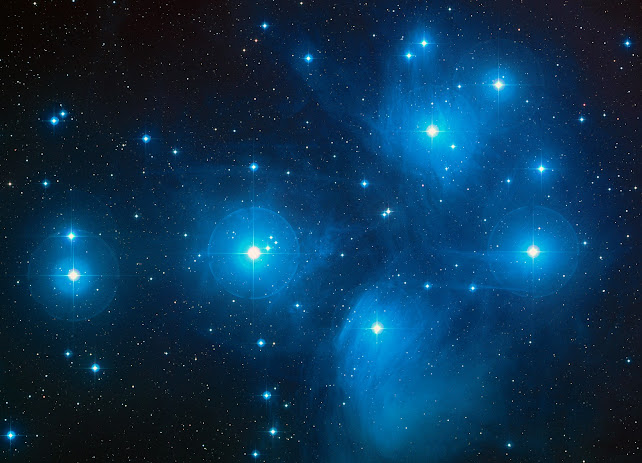
In autumn they rise in the evening twilight. As the sky darkens and the autumn air fills with ringing coolness, they rise higher and higher. Their cold brilliant shine and slight shimmering catches the eye of a night traveler. It seems that they beckon to themselves, although they remain infinitely distant, indifferent to anyone who looks at them.

They are sisters, and there are seven of them: Alcyone, Seleno, Maya, Merope, Asterope, Taygeta and Electra — all the daughters of the titanum Atlas and oceanid Pleione. They are also called Atlantidas — after the name of their father, and not in honor of the country of harmony and happiness invented by Plato (maybe Plato did not invent his own Atlantis? — we will not know this ...).
However, these stars have many other names. The Romans called them Virgils, the Slavs — Stozhars, and the Japanese — Subaru (the car brand and its logo are exactly about this). And there is no people who would not admire this scattering of stars, although the ancient Hellenes succeeded in their myths more than anyone else.
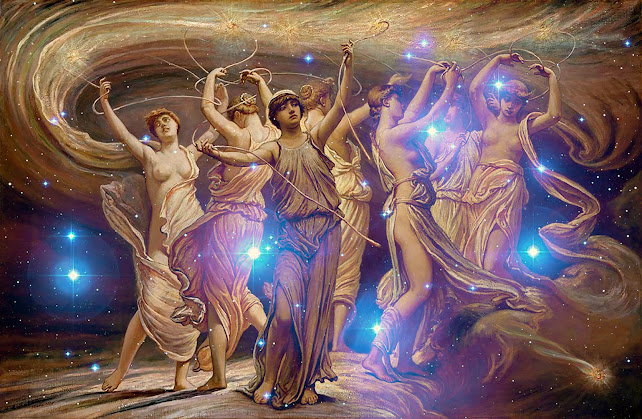
According to the Greek legend, the sisters of the Pleiades, when they grew up, became companions and servants of the goddess of hunting Artemis, but very soon attracted the attention of the Greek hunter Orion with their beauty. Artemis and Orion had a very difficult relationship — Artemis could not interrupt them, being a secret admirer of the greatest of hunters. But her retinue suffered greatly from the persecution of the violent Orion. And then Zeus intervened in the matter — he turned the Pleiades sisters into a doves, and found them another job — every day they carried Ambrosia in their beaks to Olympus — the abode of the immortal Gods of Hellas, because Ambrosia gave to Gods their immortality and eternal youth. The path of the doves lay between the Plankts — floating rocks, which diverged for a very short time, during which only six doves could fly between them. Seventh dove was lost, died. But Zeus every day resurrected the dead pleiade-dove.
To be honest, there was little good in the salvation of the Pleiades invented by Zeus. In addition, very soon Orion found out where his passions had gone, and began to pursue the doves. Zeus had no other choice but to turn the sisters into a scattering of stars. But, according to the irony of Greek myths, Orion soon got there — to heaven — after an unsuccessful date with Artemis and the poisonous bite of Scorpio. And here he is again chasing the Pleiades — already on the crystal celestial sphere.
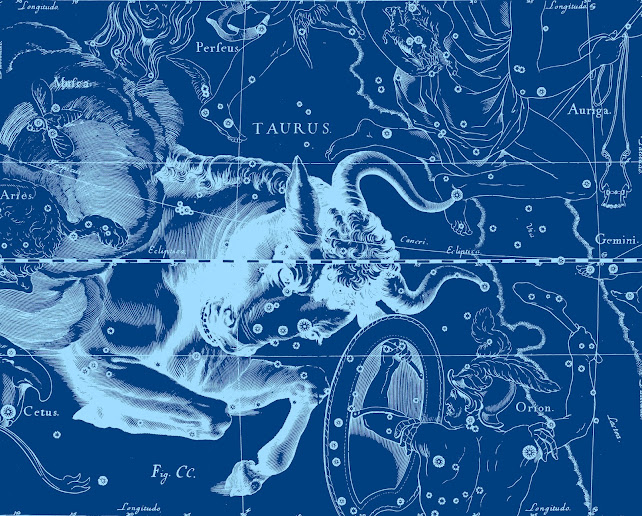
What would the immortal Gods have been doing all their eternity if, on the instructions of Zeus, Prometheus had not molded people from clay? But what's done is done. And now the greatest of the celestials is forced to save his divine creatures from the madness of mortals.
And then Zeus raised to heaven the same bull that shortly before that had kidnapped the nymph Europa for him — why not a reward for excellent service? And also an increase. Now the star bull — Taurus — guards the seven-starry Pleiades from the possessed Orion, who has already forgotten about his doves, raised a huge wooden club and fights with the "Heavenly Bull". And during this battle, the Pleiades feel completely safe in the thick withers of Taurus.

On a sky map, an open star cluster is located in the western part of the constellation Taurus. Also, it is very easy to find it by continuing one of the curved branches of the constellation Perseus. But even if you do not know exactly where to look for these stars, but they have already risen, looking around the sky you will quickly find them, because it is impossible to confuse the Pleiades with anything else.
It is worth adding that on the modern map, the Pleiades also include their parents — the titanum Atlas and the oceanid Pleion. They are a little apart, yet they belong to this open cluster. And Asterope turned out to be a double star — the ancient Greeks did not know about it. But now in the Pleiades you can see two Asteropes at once: Asterope 1 and Asterope 2.

However, the very concept of a "double star" in a conversation about the Pleiades may seem absurd, because all the stars of this cluster are gravitationally bound — to a greater or lesser extent. They represent a single system that has been flying compactly across the expanses of the Milky Way for 115 million years — this is exactly the age (according to astronomers) that the Pleiades star cluster has.
These are very young stars, born quite recently. In modern photographs, the stars are surrounded by a blue veil — a gaseous nebula. And when the veil was discovered, astronomers assumed that it was from this cloud of interstellar gas that all the stars of the Pleiades originated. It is now known that this is not the case. The Pleiades encountered this nebula on their way through the Galaxy — they are now flying through it, and in time the veil will be left behind. But who knows, what if they have another veil on their way?
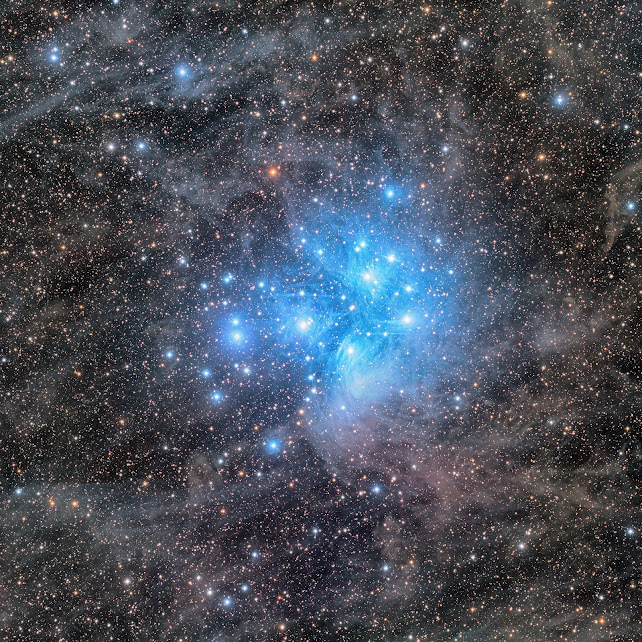
It is worth recalling that our Sun also acquired all its planets, also passing through one of the nebulae on its stellar path. But it was a nebula of a different kind — the remnant of a supernova, a cloud of gas rich in heavy chemical elements, from which all the planets, including our Earth, were later formed.
The nebula that envelops the stars of the Pleiades cluster today belongs to gas and dust. It has enough hydrogen to give birth to some of the next generation of stars over time. But it also contains a lot of dust, which is so common in the spiral arms of our Galaxy. And indeed — look at the map — the Pleiades are just visible in the direction of the Milky Way and moving along the arm of Orion.
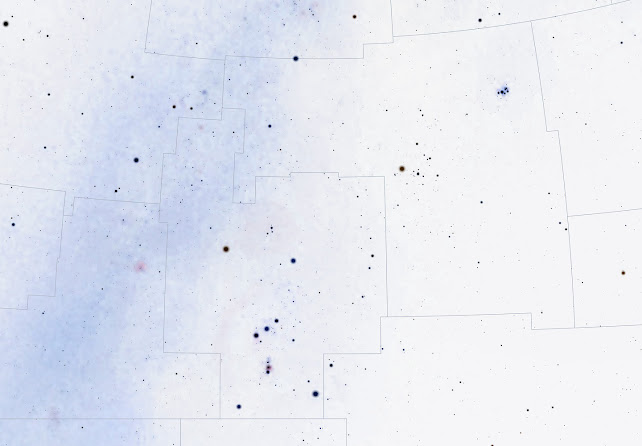
Today, more than 1,000 stars are known in this cluster. True, it is assumed that the total number of stars in the Pleiades is much larger — about three thousand, but the vast majority of them are low-mass brown dwarfs. At this distance, they are unlikely to be detected. The distance to the cluster is estimated at 440 light-years — half the way to the Orion Nebula.
In the Pleiades, only a few stars are visible to the eye. It is believed that a person with normal vision sees 6-7 stars in a cluster. People with exceptional vigilance can count 10-12 stars, sometimes more. Of course, this requires special conditions — the absence of urban illumination, a clean transparent atmosphere, and preferably a mountainous area. Nearsighted people can also see the Pleiades, but they see them as a blurry, hazy patch larger than the moon. There is an assumption that astronomical observations contribute to the restoration of vision. And the desire to clearly see more stars in the Pleiades has its benefits.
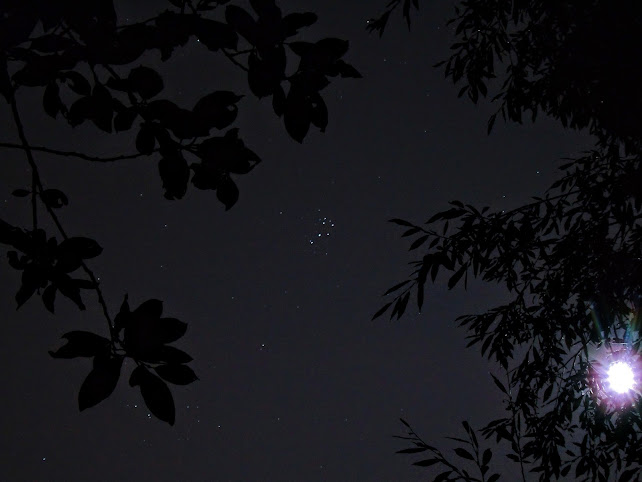
In his very first telescope, Galileo Galilei counted 40 stars in the Pleiades. In modern budget binoculars and spyglasses, you can see even more — about a hundred.
The group of stars in the Pleiades cluster seems very compact to the eye, and even small. But only until the Moon is near. And the Moon is next to the Pleiades once a month. Of course, the Pleiades is a little more difficult to look at under the Moon, especially if the Moon is close to a full moon. But if the stars of the Pleiades continue to be visible, it immediately catches the eye that the Pleiades are several times larger than the Moon.
Rarely — once every 18 years — the Moon passes through the Pleiades, covering some of the stars. But she fails to close the cluster completely.
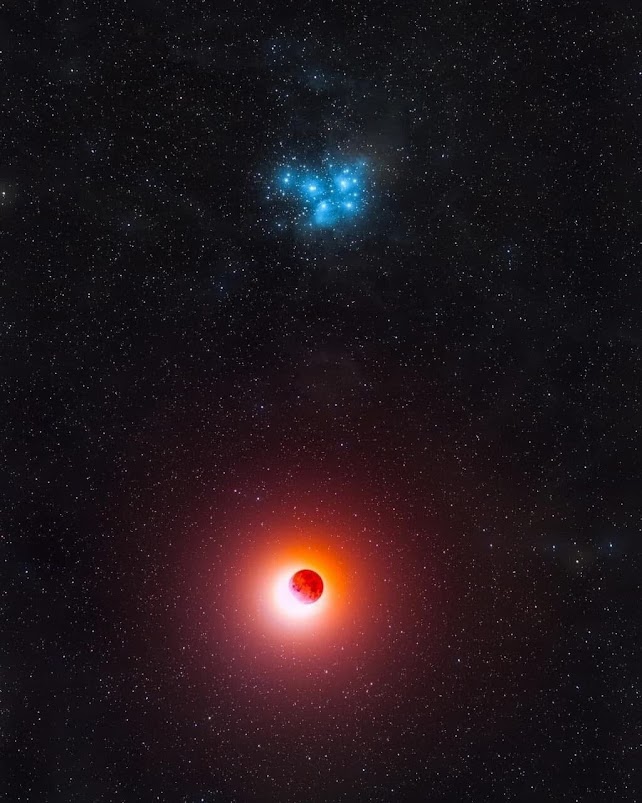
If the apparent diameter of the Pleiades is about 2 degrees, then the physical dimensions of the cluster seem very impressive — 12 light years. And if we assume that the cluster really has 3000 stars, then we will get a rather high density of stellar population here — 10 stars per 1 cubic light year, with an average distance of less than 1/2 light year from star to star.
If there was an intelligent technocratic civilization in the Pleiades, it could very quickly master the entire cluster — a few years of flight, and you are already colonizing the next star. By the way, among lovers of the occult and esotericism, there is a strong belief that the Pleiades are inhabited, and the civilization that inhabits this entire cluster is many times superior to the earthly one in terms of development. It is impossible to refute this, because none of the earthlings have yet flown there, and earthly telescopes are not yet sharp enough to view all the stars of the Pleiades with the necessary detail. But still the youth of these blue stars testifies against the possible habitability of this World. After all, even planetary systems in such a short period of time — 100 million years — can hardly be fully formed. Let me remind you that the Earth is 4.5 billion years old, and life has evolved on it for at least half of this period.
Note: At the moment, one of the cluster's stars (known only under the catalog number HD 23514) is suspected of having acquired its own planetary system. But so far we are talking only about the protoplanetary disk, from which planets are formed in the next millions of years.
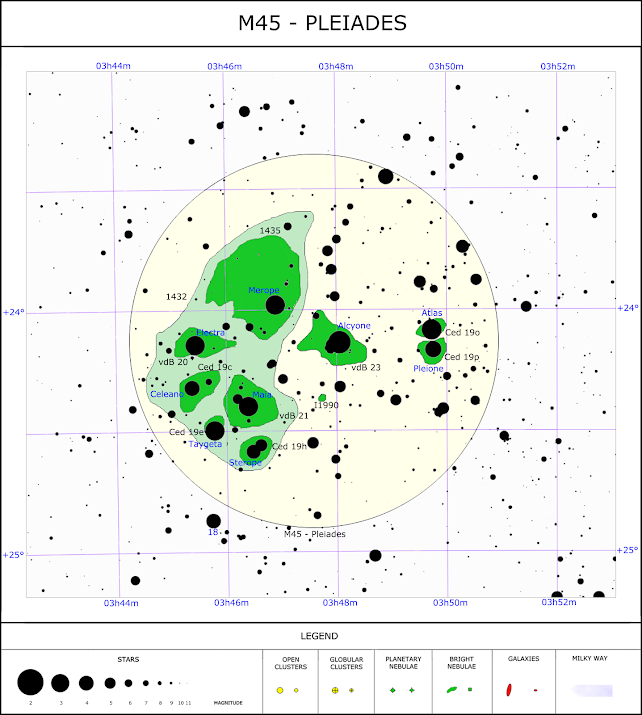
Previously, the Pleiades were even more densely populated. But over time, open clusters break up. And during its existence, most of the stars of the early Pleiades left the cluster. What we see now in the sky is a meager part of what was in the beginning. There is an assumption that in the era of the birth of the Pleiades included more than 10,000 stars. And after another 250 million years, the Pleiades will most likely completely disintegrate, and each of the stars of the former cluster will begin its own separate life. Although the brightest and most massive stars — those that are visible to the naked eye and have their own names — most likely will not survive this period of time. Having burned out from the inside, they will explode with supernovae, enriching the Galaxy with a large number of chemical elements, from which, sooner or later, planets will form — perhaps even habitable ones.
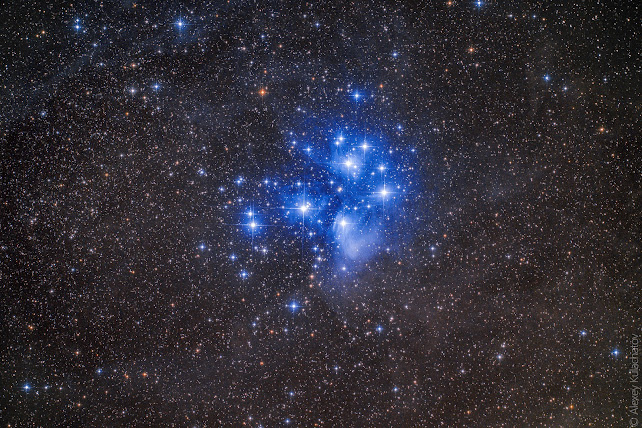


No comments:
Post a Comment